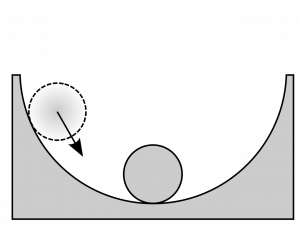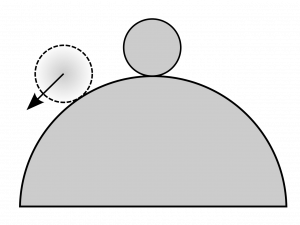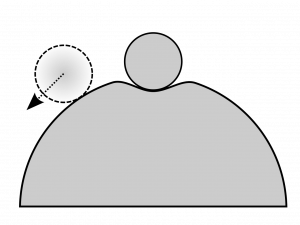45 Types of Stability
Stable Equilibrium
If a structure is pushed out of equilibrium we say it has been displaced from equilibrium. If the object tends to move back toward its equilibrium position then it must be in a region of stable equilibrium and the force that pushed it back is a restoring force.

As your arm hangs from your shoulder, it is in stable equilibrium. If your arm is lifted to the side and then let go it will fall back down to the hanging position. The hanging arm is a stable position because the center of gravity of the arm is located below the base of support, in this case the shoulder. When displaced (lifted a bit) the force of gravity acting on your arm will cause a torque that rotates your arm back down to the hanging position. In such cases, when an object is displaced from the equilibrium position and the resulting net forces (or torques they cause) move the object back toward the equilibrium position then these forces are called restoring forces. The sloth takes advantage of stable equilibrium to save energy that humans spend on staying upright. If the sloth is displaced in any direction, the force of gravity automatically acts as a restoring force and returns the slot to its equilibrium position.

Unstable Equilibrium
When a system in equilibrium is displaced and the resulting net force pushes the object even further away from the equilibrium position then it must have been in an unstable equilibrium. Technically, real systems cannot spend time at unstable equilibrium point because the tiniest vibration will cause them to move out of equilibrium not to mention that you could never place them perfectly into position in the first place. Trying to balance a marble on a hill is a good example:

Metastable Equilibrium
Some structures that are in stable equilibriumand can be displaced relatively far before they are no longer in equilibrium. Other structures structures that only require a small displacement to move out of equilibrium (like toddlers). We often call these systems stable and unstable, but this can be misleading because any standing structure is somewhat stable and a truly unstable structure would not stand still for any time. These structures that are in a stable region, but could be pushed passed a tipping point are known to be in a metastable equilibrium.

Keeping your balance requires that you stay with the the stable region of a metastable equilibrium. For example, we expect that most people would say the person balancing on their head in the following image is unstable, but that wouldn’t be quite accurate. Actually, the person is actively adjusting the shape of their body to shift their center of gravityto remain within the stable region of a metastable equilibrium, though it is a narrow one.

Exercises
- "Stable Equilibrium" by Urutseg, Wikimedia Commons is in the Public Domain, CC0 ↵
- Two Toed Sloth (Choloepus didactylus) By Cliff [CC BY 2.0 (https://creativecommons.org/licenses/by/2.0)], via Wikimedia Commons ↵
- "Unstable Equilibrium" by Urutseg, Wikimedia Commons is in the Public Domain, CC0 ↵
- "Meta-stable Equilibrium" by Urutseg, Wikimedia Commons is in the Public Domain, CC0 ↵
- By Usien [CC BY-SA 3.0 (https://creativecommons.org/licenses/by-sa/3.0)], from Wikimedia Commons ↵
a state of having no unbalanced forces or torques
pushed out of original position, typically in reference to fluid pushed out of the way by an object placed in the fluid, or an object being displaced from its equilibrium position
a state in which a body tends to return to its original position after being disturbed
a force that tends to move a system back toward the equilibrium position
a point at which the force of gravity on body or system (weight) may be considered to act. In uniform gravity it is the same as the center of mass.
region defined by lines connecting points of contact with the supporting surface
attraction between two objects due to their mass as described by Newton's Universal Law of Gravitation
the result of a force applied to an object in such a way that the object would change its rotational speed, except when the torque is balanced by other torques
the total amount of remaining unbalanced force on an object
a state of equilibrium such that when the body is slightly displaced it departs further from the original position
a state in which a slight disturbance results in a restoring force that maintains stability, but a sufficiently large disturbance moves the system into an unstable region (or different metastable region)

